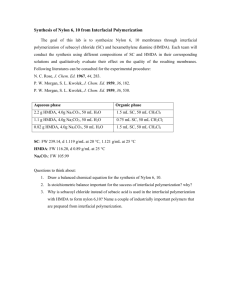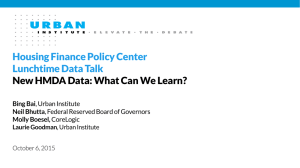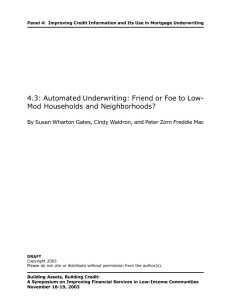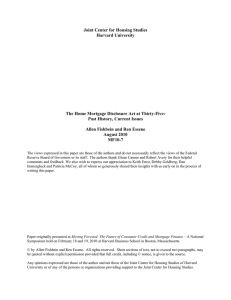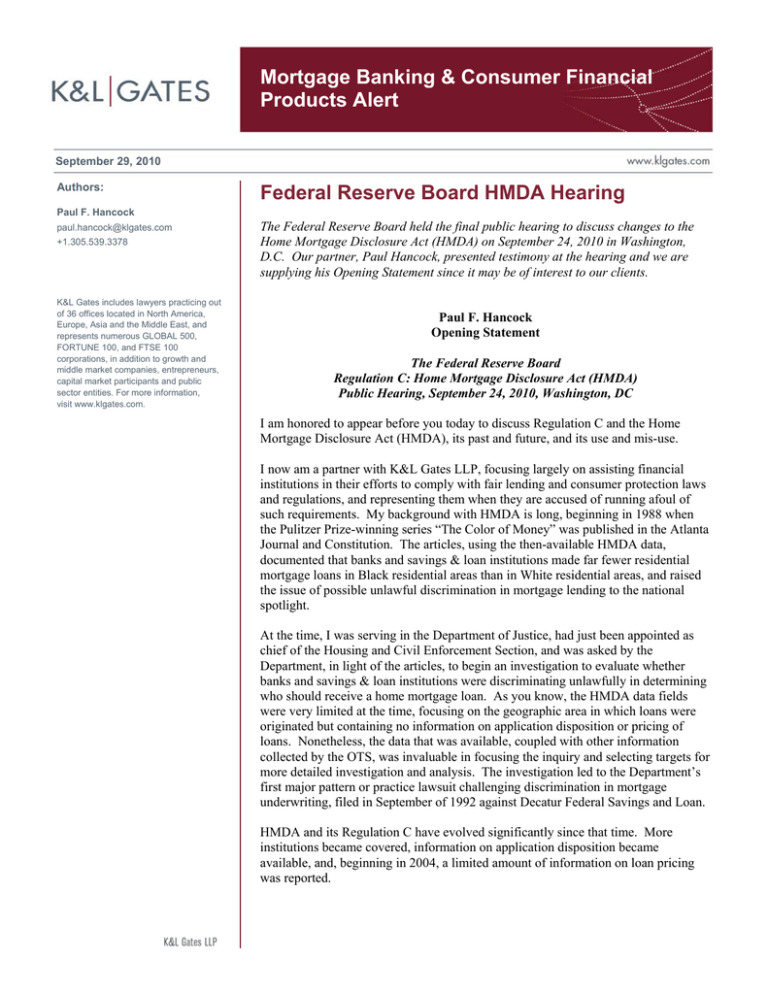
Mortgage Banking & Consumer Financial
Products Alert
September 29, 2010
Authors:
Federal Reserve Board HMDA Hearing
Paul F. Hancock
paul.hancock@klgates.com
+1.305.539.3378
K&L Gates includes lawyers practicing out
of 36 offices located in North America,
Europe, Asia and the Middle East, and
represents numerous GLOBAL 500,
FORTUNE 100, and FTSE 100
corporations, in addition to growth and
middle market companies, entrepreneurs,
capital market participants and public
sector entities. For more information,
visit www.klgates.com.
The Federal Reserve Board held the final public hearing to discuss changes to the
Home Mortgage Disclosure Act (HMDA) on September 24, 2010 in Washington,
D.C. Our partner, Paul Hancock, presented testimony at the hearing and we are
supplying his Opening Statement since it may be of interest to our clients.
Paul F. Hancock
Opening Statement
The Federal Reserve Board
Regulation C: Home Mortgage Disclosure Act (HMDA)
Public Hearing, September 24, 2010, Washington, DC
I am honored to appear before you today to discuss Regulation C and the Home
Mortgage Disclosure Act (HMDA), its past and future, and its use and mis-use.
I now am a partner with K&L Gates LLP, focusing largely on assisting financial
institutions in their efforts to comply with fair lending and consumer protection laws
and regulations, and representing them when they are accused of running afoul of
such requirements. My background with HMDA is long, beginning in 1988 when
the Pulitzer Prize-winning series “The Color of Money” was published in the Atlanta
Journal and Constitution. The articles, using the then-available HMDA data,
documented that banks and savings & loan institutions made far fewer residential
mortgage loans in Black residential areas than in White residential areas, and raised
the issue of possible unlawful discrimination in mortgage lending to the national
spotlight.
At the time, I was serving in the Department of Justice, had just been appointed as
chief of the Housing and Civil Enforcement Section, and was asked by the
Department, in light of the articles, to begin an investigation to evaluate whether
banks and savings & loan institutions were discriminating unlawfully in determining
who should receive a home mortgage loan. As you know, the HMDA data fields
were very limited at the time, focusing on the geographic area in which loans were
originated but containing no information on application disposition or pricing of
loans. Nonetheless, the data that was available, coupled with other information
collected by the OTS, was invaluable in focusing the inquiry and selecting targets for
more detailed investigation and analysis. The investigation led to the Department’s
first major pattern or practice lawsuit challenging discrimination in mortgage
underwriting, filed in September of 1992 against Decatur Federal Savings and Loan.
HMDA and its Regulation C have evolved significantly since that time. More
institutions became covered, information on application disposition became
available, and, beginning in 2004, a limited amount of information on loan pricing
was reported.
Mortgage Banking & Consumer Financial Products Alert
Government enforcement of fair lending laws
benefited greatly from the availability of HMDA
data. As information on the disposition of
applications became available, the Department of
Justice reviewed it carefully to look for seemingly
abnormal disparities in minority vs. non-minority
rejection rates, or even more subtle issues such as
high levels of withdrawn applications.
HMDA data was universally viewed as only a
starting point for more detailed analysis, and
complex, time-consuming, resource-intensive
investigations were always required to justify the
filing of a legal claim. The federal government
never filed a lawsuit based solely on HMDA data,
and private litigants seemingly shared the view that
a claim based solely on HMDA data would not
survive judicial scrutiny. That is not to say that
HMDA data did not raise eyebrows, with high
disparities in rejection rates between minorities and
non-minorities; but it was viewed that a detailed
investigation was necessary to reach meaningful
conclusions.
The loan pricing information that first became
available in 2005 was much more limited than
application disposition information. Pricing
information was available only for loans that met the
rate spread threshold. Designed to capture the bulk
of subprime loans and exempt the bulk of prime
loans, the thresholds have been imperfect. In the
industry, subprime loans were viewed as a product.
Yes, they were priced higher than prime loans, but
with some frequency the attributes of prime loans
also pushed the rate above the applicable threshold.
Again, federal government agencies have used this
newer data to target lenders for more detailed
investigation. The data may be a starting point, but
it hardly forms a basis for reaching meaningful
conclusions regarding the fairness of the pricing
practices of financial institutions.
In recent years, however, we have often seen what I
believe is a misuse of the HMDA data. While racial
and ethnic underwriting disparities have persisted
for the twenty year period that the data has been
reported and yet have not been thought to be
sufficient to justify legal claims, the new and
significantly more limited pricing information has
been the sole basis for a significant number of
private lawsuits. Rate-spread reportable loans have
been labeled as “subprime loans” or even “high cost
loans,” with strong suggestions, if not claims, that
they are per se invidious. None of these cases has
proceeded to a decision on the merits, and yet they
have imposed a significant reputational and
financial burden on the defendant institutions.
HMDA subjects residential mortgage lenders to
disclosures that are not applicable to any other
segment of American business, including companies
engaged in other types of credit transactions. Yet
the focus remains on expanding the fields of public
information available for residential mortgage credit
transactions. Dodd-Frank addresses much of the
future of HMDA by requiring the reporting of many
new fields of data.
The new legislation continues the trend of reporting
more loan level information about residential
mortgage transactions. As I have reviewed the
statements of the economists who have presented to
you, I find it interesting that they call for even more
information. Perhaps their profession itself calls for
more data and they want what is necessary to
conduct meaningful and full analyses. But this
brings us back to question the underlying purpose of
HMDA.
Is the purpose to provide basic information about
residential mortgage transactions so that more
detailed reviews can be conducted when thought to
be necessary? Or is the purpose to provide
sufficient information to allow government agencies
as well as private persons to determine whether
individual borrowers are treated fairly? HMDA
began with a focus on the first question, but we now
are reaching toward data that likely will be used in
an effort to address the second question.
Residential mortgage transactions, however, remain
complex, and it will be difficult to form meaningful
conclusions without considering the totality of
circumstances presented by the loan file, which will
remain beyond the reach of HMDA. It is important
for the Board to clearly state that fact to advance
proper use, and not misuse, of the data.
I appreciate that the focus of your review is on the
broader issues, but I also suggest that you give some
consideration to the more technical issues that
September 29, 2010
2
Mortgage Banking & Consumer Financial Products Alert
HMDA presents. For example, the “broker rule and
the meaning of ‘broker’ and ‘investor’” may raise
issues in the current fair lending environment. Even
at the height of the market, some loan purchasers
were heavily involved in underwriting decisions,
thus suggesting that they should be (but were not
always) the reporting entity. We may continue to
see increased investor involvement in the current
market conditions. At the same time, the entity that
made the credit decision may not have been
responsible for the loan price. If the lender is the
reporting entity, denial disparities may not reflect its
practices, and if the investor is the reporting entity,
pricing disparities may not reflect its practices.
Also, the guidance that the FRB has offered over the
years on the use of reporting codes such as
“withdrawn,” “approved but not accepted,” or
“denied” has been confusing, particularly in the
context of technology. Automated underwriting
approvals are regularly subject to many conditions,
and it is not clear when the failure to satisfy the
conditions constitutes a “denial” or an application
that was “approved but not accepted.” The Board’s
2002 guidance on the issue is inadequate in that it
suggests that “customary conditions” (that would
authorize the use of “approved but not accepted”)
might range from title difficulties, to amount of
appraisal, to amount of compensation. Many would
consider some of these to be “underwriting
conditions” rather than “customary closing
conditions,” and yet in 2002 the Board declined to
provide clarity.
Also, the issue of when a credit decision has been
made, and thus rendering “withdrawn” no longer
permissible, may vary greatly among lenders with
no clear guidance from the Board.
Lenders can expect that their HMDA data will be
subjected to detailed review by a host of
government and private parties. The Board should
provide the guidance necessary to promote
consistency and help ensure that the data reported
accurately describes the practices of the reporting
institution.
Anchorage Austin Beijing Berlin Boston Charlotte Chicago Dallas Dubai Fort Worth Frankfurt Harrisburg Hong Kong London
Los Angeles Miami Moscow Newark New York Orange County Palo Alto Paris Pittsburgh Portland Raleigh Research Triangle Park
San Diego San Francisco Seattle Shanghai Singapore Spokane/Coeur d’Alene Taipei Tokyo Warsaw
Washington, D.C.
K&L Gates includes lawyers practicing out of 36 offices located in North America, Europe, Asia and the Middle East, and represents numerous
GLOBAL 500, FORTUNE 100, and FTSE 100 corporations, in addition to growth and middle market companies, entrepreneurs, capital market
participants and public sector entities. For more information, visit www.klgates.com.
K&L Gates comprises multiple affiliated entities: a limited liability partnership with the full name K&L Gates LLP qualified in Delaware and
maintaining offices throughout the United States, in Berlin and Frankfurt, Germany, in Beijing (K&L Gates LLP Beijing Representative Office), in
Dubai, U.A.E., in Shanghai (K&L Gates LLP Shanghai Representative Office), in Tokyo, and in Singapore; a limited liability partnership (also named
K&L Gates LLP) incorporated in England and maintaining offices in London and Paris; a Taiwan general partnership (K&L Gates) maintaining an
office in Taipei; a Hong Kong general partnership (K&L Gates, Solicitors) maintaining an office in Hong Kong; a Polish limited partnership (K&L
Gates Jamka sp.k.) maintaining an office in Warsaw; and a Delaware limited liability company (K&L Gates Holdings, LLC) maintaining an office in
Moscow. K&L Gates maintains appropriate registrations in the jurisdictions in which its offices are located. A list of the partners or members in each
entity is available for inspection at any K&L Gates office.
This publication is for informational purposes and does not contain or convey legal advice. The information herein should not be used or relied upon
in regard to any particular facts or circumstances without first consulting a lawyer.
©2010 K&L Gates LLP. All Rights Reserved.
September 29, 2010
3


